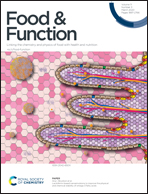Replacement of forage fiber with non-forage fiber sources in dairy cow diets changes milk extracellular vesicle-miRNA expression†
Abstract
Milk is a dynamic source of nutrients and bioactive factors, varying with the nutrition status of the cattle. We partly replaced alfalfa hay with whole cotton seed and soybean hull (non-forage fiber source, NFFS) in the feed formula of treated cows and evaluated the effects on milk extracellular vesicles (EVs). The NFFS supplement did not affect the shape of milk EVs observed using a transmission electron microscope. Nanoparticle tracking analysis revealed that the EV concentration increased significantly in treated cows (P = 0.019), with the peak diameter unaffected by the treatment. The EV-RNA concentration and small RNA content, particularly rRNAs and tRNAs, significantly increased in the treated cows (P < 0.05). The other small RNAs, i.e. miRNAs, cis-regulatory elements, snRNAs, and other Rfam RNAs showed no significant difference between the two groups. Totally 276 milk EV-miRNAs were identified. Thirteen miRNAs, accounting for 76%, in the highly expressed top 20, were immune-related. In addition, 9 differently expressed miRNAs (4 up-regulated and 5 down-regulated) were identified (P < 0.05). Kyoto Encyclopedia of Genes and Genomes pathway analysis showed that the differently expressed miRNAs were related to the citrate cycle, fat digestion and absorption process, taurine and hypo-taurine metabolism, and glycosphingolipid biosynthesis. This study documents the milk nutrition assessment from macromolecules, especially EVs.



 Please wait while we load your content...
Please wait while we load your content...